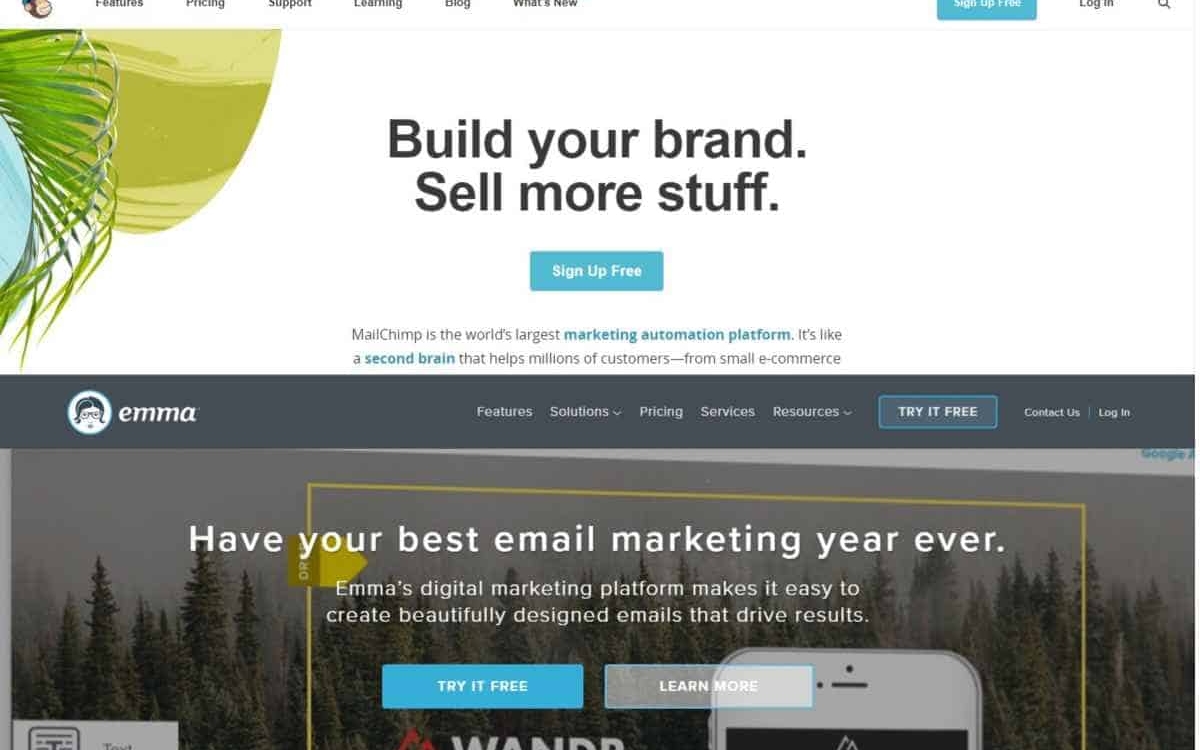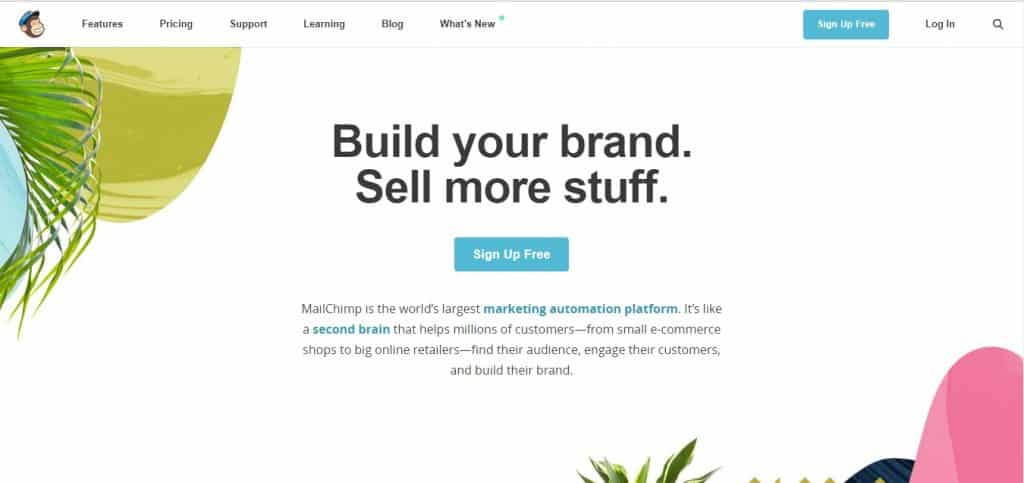Emma vs MailChimp: Which Email Marketing Software is the One for You?

When you buy something through one of the links on our site, we may earn an affiliate commission.
If you're not using email marketing as part of your online business, then you're missing out on a lot. Hopefully, we can cover as much ground as possible regarding the importance of email in this Emma vs MailChimp post. For now, we can start with the actual value it can provide for your organization.
Email marketing is one of the most effective channels to acquire leads and converting them into customers. When done correctly, you can also acquire and retain customers by using the automation features available in your chosen software. The goal is to unburden you from constantly reaching out to subscribers and customers in a timely manner.
Through email marketing, you can schedule your messages and set up recipes and triggers that will automatically send emails to people in your list. As a result, you can create better rapport with people in your email list, which could lead to greater sales and opportunities.
If you're already employing email marketing, then you need to be aware of the different platforms that you can use for this. As your business grows, you need to choose an e-mail service that will take care of your e-mail campaigns without compromising email deliverability and incurring the cost of hiring a sales team.
Unfortunately, not all platforms are made the same just like not all businesses are cut from the same cloth. The type of email marketing service you must be using depends on the kind of business that you have.
While Emma and MailChimp are both email marketing platforms, they each have features exclusive from each other. These will be critical in your search for the best email marketing service for your business so you can serve your customers and leads better.
In this Emma vs MailChimp review, you will learn:
- The different strengths and weaknesses of both tools
- Compare both tools based on their features
- Determine which email marketing software works best for which business
Emma vs MailChimp: the tale of the tape
To prompt us in this head to head battle, we need to discuss each software in a bubble to understand better how Emma and MailChimp serve their customers better. From there, we will continue talking about hallmarks of both, as well as their shortcomings.
Once we have established these things, we can pit them side by side and see which tool holds the edge over the other based on metrics to be discussed later on.
About Emma

While associated more with email marketing, Emma is really more of a digital marketing platform that just an email app. If you need help getting the best ROI for your online business, Emma offers features other than email marketing for businesses like yours to reach their goals.
In the meantime, let's focus on what makes Emma great as an email marketing software:
Go to MyEmma.comMarketing automation
Emma helps you create and send personal, timely, and relevant messages to your subscriber list. You can create triggers to send people when they perform a specific action on your site. Once you have their email, you can create a customer profile by asking subscribers to fill out a short form asking people about their likes and preferences.
Once sent, you can set Emma to send them another email populated with topics and information related to their answers on the form.
This personal approach via marketing automation helps foster a more genuine relationship between your customer and brand. More importantly, you can set and forget the recipes and triggers at Emma. Once visitors become subscribers, Emma does the heavy lifting for you.
List segmentation
If you want to deliver more targeted emails to your subscribers, you can create an unlimited number of segments for like-minded and similar subscribers on your list. From here, you can craft an email specific to that segment in the hopes of increasing your conversion rate.
Aside from manual segmentation, you can set Emma to create segments for you or includes subscribers to the segment they belong to using the tool's dynamic and intuitive segment builder.
Dynamic content

Create personized emails to your subscribers so they will only see content that resonates with them. Emma will dynamically take care of which content will appear in the email. You just to do this once and let the software do the heavy lifting. Also, you can design email templates using the tool's drag and drop builder to create beautiful and compelling messages.
A/B content testing
If you want to make the most out of the emails you sent, Emma lets you determine which version of the same email works best based on how many opened the email and clicked on the link in it. You can put different variables to the test and tweak them as you see fit later on once the results arrive.
Using this feature will help you improve your email campaigns and replicate your success in upcoming campaigns for your brand.
Landing pages
Using the drag and drop technology for its email builder, Emma applies the same tech for its landing page builder. Even if you don't have any design experience, you can still create beautiful pages with the intention of increasing your conversion rate and hiking up your subscriber count if not customer base through an embeddable opt-in email form!
Once published, the page will have a unique URL that remains the same even if you edit and revise the page. To monitor the progress of the created landing pages, you can integrate Google Analytics to get the necessary data to help you optimize them as necessary.
Email editor
Aside from the drag and drop email builder, you can also create emails from scratch using HTML. If you're an experienced coder and developer or are working with one, Emma affords you the luxury of customizing your email messages with greater freedom and flexibility so you can effectively communicate your message.
Once finished, you can preview the email using Litmus email preview so you can see the finished product before hitting “send.”
Email signup forms
Sign-up forms are already a given in an e-mail marketing platform. With Emma's, you can guarantee that each form you create is mobile responsive so you can collect more emails whether that person is using a desktop or mobile device. Also, you have full control over when and where the form will show on the screen of your visitors for optimum sign-up.
If you attend seminars and meetups and want to get the information of people you meet, you can install Guestbook on your iOs device. You can create a form that people can sign up. Not only do you get their personal information but you also eliminate the need for keeping business cards.
Email analytics
To create better email campaigns, you need to know how your previous ones performed. From there, you can determine the shortcomings of your campaigns and make a concerted effort to develop more improved campaigns, whether they are an email newsletter or drip campaign. emma offers a variety of parameters that you can measure for each campaign:
- Response dashboard – You can view how many people opened your email and how many clicked in the link or replied. Based on these figures, you can build upon the results to develop even better campaigns moving forward. For the best results, you must test different versions of your email and see more comprehensive data for your emails.
- Mailing score – Refer to the aggregate score based on different factors as the benchmark to the quality of your email. This is an easy and convenient way to determine your campaign's quality without having to wrap your brain around the different facets of your email.
- Click map – Find out the exact areas of your email where people are clicking so you know where you should place your calls to action to improve your email's click-through rate.
You can view the analytics from your mobile device using Metric, an iOs and Android app that delivers the most relevant metrics from Emma so you can stay updated with the performance of your email campaigns on the go.
Integrations
To help you with your digital marketing initiatives, Emma syncs up perfectly well with the best third-party apps like Google Analytics, Zapier, SurveyMonkey, Eventbrite, and a lot more.
Pricing

Emma offers their digital marketing platform starting with the PRO plan at $89/month – perfect for small businesses who want to do email marketing right the first time. The package lets you contact 10,000 people. The +PLUS plan ($369/month) lets you reach out to 25,000 contacts.
The bigger companies with established contacts, the Enterprise plan lets you contact 75,000 people at $729/month.
About MailChimp

As the standard-bearer of email marketing for years, MailChimp has grown to provide offerings outside of email marketing. Below are some of the tool's best features, some of which are welcome additions to its already established email platform.
E-commerce integration
With the intention of helping you to sell more, MailChimp works together with some of e-commerce's best apps and tools. You can seamlessly use MailChimp alongside Shopify, BigCommerce, Magento, and other platforms. You can be sure to collect email addresses of your target audience and send them relevant messages without any hitch.
Through these integrations, you can monitor data, offer rewards to your best customers, manage customer relations, and more.
You can also integrate MailChimp with other tools like Salesforce, Eventbrite, Twitter, Facebook, and more. All the integration will help you get a better sense of your email marketing performance and how these channels impact the results, whether positive or negative.
Powerful marketing automation
As with most marketing automation features, you can create and set up drip campaigns and triggers that will send messages to people when they perform a particular action on your site. What makes MailChimp's marketing automation different is the creation of Google, Facebook, and Instagram ad campaigns to show people who are similar to your current customers (and don't miss our comparison Aweber vs Mailchimp here).

Google's remarketing ads allow you to reach people who aren't your customers yet but have the potential to be one on popular apps and sites. For Facebook and Instagram, you can launch a campaign to target new and old customers with the goal of increasing your sales.
You can also create an onboarding series to help new subscribers get acquainted with your brand. By slowly ingratiating them to your brand, your subscribers will feel at home with your business, which could potentially lead to more sales in the future.
If you are managing an e-commerce site, you can use MailChimp on the platform mentioned earlier to automatically recover abandoned carts for you, follow up on their purchases, and send them product recommendations based on the items they've already purchased.
Landing pages
A recent addition to MailChimp's list of features, landing pages help you increase your conversion rate so you can sell more or get more subscribers, among the many goals you can choose from. MailChimp offers two templates that you can use to build your landing pages on so you don't have to start from scratch.
This is extremely helpful for non-designers who don't know a lick in the best design practices.
Use the templates wisely to create landing pages with the goal of showcasing your products, running a giveaway, announcing a pre-sale, and more. After a period of promoting your landing page, you can check and see the data that breaks down its performance based on clicks, revenue, and conversions.
Best of all, you can create landing pages with your initial free account so you can maximize the pages to benefit your business.
Revenue-based analytics
If you want to get the low-down of your e-commerce site, then you will love MailChimp's analytics feature. You can get a general sense of your email marketing campaign based on different factors that influence your profitability. From the analytics page, you will see the interaction of your subscribers with your e-mail campaign.
Monitor the trends of your campaigns over time and see how many joined or left in your email list. All the data is presented via interactive graphs to make for a more dynamic and easy-to-understand report for you.
Do email marketing from your mobile device
If you're on the go but need to send something to your subscribers, you can do so on the official mobile app of MailChimp. Create campaign as you would on the desktop version. Add and remove content blocks, view your campaign analytics, manage your subscribers, and more. You can also configure the app to send you notifications on your device for new sales.
Flexible API
To support more tools who want to use MailChimp to improve their workflow, the marketing platform is offering its API to be used for various reasons. It has extensive documentation on API so you can export your MailChimp to specific tools in your marketing arsenal.
Pricing

MailChimp is one of the most popular email marketing tools for a lot of reasons, and one of those is pricing. You can register for a free account with a limit of 2,000 subscribers. Once you hit over 2,000 sign-ups, pricing starts at $10/month.
Until then, however, the Forever Free plan is perfect for marketers and businesses who are still building up their email list and customer base. It has limitations such as the 12,000 maximum email sends per month and the lack fo segmenting and analytics features, but you don't have to pay for it to send emails.
The Pro plan is $199/month which includes exclusive features such as advanced segmentation, multivariate testing, and comparative reports on top of the ability to send unlimited emails.
A head-to-head comparison of Emma vs MailChimp
To effectively compare both email marketing tools, below are the parameters that we will use for this review. They are by no means the be-all-end-all criteria for email marketing, but I will use them in this review to set up the foundation of how to analyze both tools based on their strengths and weakness.
- Ease of use – This may seem like a subjective criterion, but it nonetheless helps you understand how to set up the tool for your business. The ability to create campaigns on the go and review their reports is crucial especially for decisionmakers who are not tech-savvy and want to see how a tool delivers results fast.
- Features – You need a tool that answers your needs as a business owner. The volume of features doesn't matter as much in this case. It's how useful and valuable the features are in growing one's business and increasing its revenue.
- Support – You will encounter problems and issues using a tool. When all else fails, it's the responsibility of the support team to fix and resolve the issue at hand. Their ability to find solutions to complex problems encountered by customers is key to retaining their customers like yourself.
- Pricing – The value of a tool or software is adjacent to its price. Expect extremely valuable email marketing tools to be expensive although the reason for the pricing may have to do with their target audience. Nonetheless, it is also possible that the tool is really a bang for your buck because it offers premium features that are reserved for more pricey software.
Now that we have established the parameters, it's now time to compare both tools.
Ease of use
Emma offers a lot of features that are useful for online businesses. The tool seems to focus on its ability to create triggers and drip campaign to segmented subscribers using its marketing automation features. The drag and drop builder for email and landing pages are perfect for design-challenged business owners whose goal is to increase engagement and ROI.
As for the email analytics, the mailing score is a great way to understand your email's predicted performance without having to manually check each facet of your email campaign. The Click Map is also very helpful especially if you want to increase the CTR of your emails.
MailChimp shares almost the same core features as Emma. It has marketing automation, email and landing page creation using the drag and drop builder, and robust analytics. It may not have the analytics and segmentation features that make Emma a breeze to use.
However, creating campaigns and messages is arguably much more convenient. The streamlined UX makes MailChimp intuitive enough for people without any background with email marketing to get acquainted with the tool.
As is stands, both tools work similar to each other than a tie is warranted.
Advantage: none
Features
Emma offers other features to complement its email marketing function. You can create sign-up forms from the tool to increase your subscribers. It also has the Guestbook app on iOs to help supercharge your offline marketing strategy. On top of the segmentation and analytics features, you can be sure that Emma will have the back on your online business in all things digital marketing.
MailChimp, at its very core, is still an email marketing tool through and through. It doesn't pretend to be anything else. There have been additions that seem to veer away from email marketing such as the landing page creator.
However, the tool ultimately does one thing and does it pretty well, and then some! Looking deeper into the tool's feature, below are additional ones that you can't directly find on their website:
- Spam filter diagnostics – find out how “spammy” your email is and how you can improve it so that it arrives at your subscriber's inbox
- RSS-to-email – for bloggers, you can create a campaign that automatically generates the latest posts you've published so far
- Delivery by time zone – Send the email based on the time on their location for optimum open rates
- Social sharing – Share your campaign via social media to encourage them to sign up to your email list
Just for the added features to help you experiment with your marketing strategy and campaign, I'll have to give the nod to MailChimp.
Advantage: MailChimp
Support
Emma offers online chat and email if you want to reach out to their support group for any concerns about your subscription. They also have a knowledge base that answers the most common questions encountered by users. You can expect a reply soon if you filled out their form especially if one of their representatives are online at the moment.
MailChimp also has a dedicated information bank of articles on how to use the tool to the fullest. However, they only offer form submission when it comes to queries. You can't be sure when to receive a reply from them considering that they may be juggling different questions from users all the time. Also, Pro support is only reserved for Pro users.
By default, I have to give this round to Emma. With more people looking for answers to their questions the fastest way possible, Emma is more equipped to manage questions due to the variety of ways to reach out to them.
Advantage: Emma
Pricing
This is where MailChimp shines the brightest. It is known for its Forever Free plan. As long as you don't hit over 2,000 subscribers, you can send emails and manage your contacts for as long as you want! More importantly, the pricing for their services isn't a lot compared to Emma, the cheapest of which is almost $100/month.
If you haven't built an email list yet, then it only makes sense to initially go with MailChimp to try your luck first. By the time you have over 2,000 subscribers, you should be able to shoulder the minimum $10/month fee without problems.
Advantage: MailChimp
Verdict for Emma vs MailChimp
Both Emma and MailChimp are more than capable email marketing platforms to help you achieve your business goals. At the onset, MailChimp positions itself to be the premier choice for e-commerce sites, although it also serves any type of online business just as well consider it has the Forever Free plan.
Emma is geared towards start-up companies who want to provide their audience with personalized emails that resonate their needs.
Despite their respective target audiences, it would be foolish not to take MailChimp for a spin. It can do things that Emma does but without the exorbitant monthly fees. If you want a more focused email campaign, then Emma provides the segmentation features necessary to pull this off.
It's analytics also helps simplify the process of reviewing your campaigns to create better ones moving forward.
However, I would personally give MailChimp the edge. Aside from the price, it's just a much more robust email marketing platform. It also offers remarketing ad campaigns to help you acquire more leads and customers via Google. Emma is arguably just as good, if not better in certain respects, but the pricing will force businesses to look for more affordable services.
So, what do you think of the Emma vs MailChimp? Do you agree with the assessment? Do you have experiences using both tools that you want to share here? Feel free to chime in by commenting below!
Check out our article Flodesk vs Mailchimp for another comparison.
Want to learn step-by-step how I built my Niche Site Empire up to a full-time income?
Yes! I Love to Learn
Learn How I Built My Niche Site Empire to a Full-time Income
- How to Pick the Right Keywords at the START, and avoid the losers
- How to Scale and Outsource 90% of the Work, Allowing Your Empire to GROW Without You
- How to Build a Site That Gets REAL TRAFFIC FROM GOOGLE (every. single. day.)
- Subscribe to the Niche Pursuits Newsletter delivered with value 3X per week
My top recommendations

















1 Comment
Conversation
To be honest, I’m hearing Emma for the first time. Sounds like a great software to manage email newsletters and autoresponders.
When I first started blogging, I tried MailChimp for obvious reason: it’s free to use up to 2000 email subscribers. Not only that it has amazing features to manage your email subscribers and send newsletters.
That being said, everyone who is serious about building a profitable online business should focus on building and growing their email lists: because that’s where the money as. If you ignore it, you’ll hate yourself later.
As you said above, sending personal, timely, and relevant messages to your subscriber list is the most important task when it comes to building a thriving email list. That’s where email marketing software like MailChimp, AWeber etc come into place. Although AWeber is a great alternative but it has its cons.
I’ll definitely give a try to Emma (currently I’m using Drip to manage all my email lists and newsletters, so far no complaints about it).
Thanks so much for sharing the comparison post with us Christopher. Keep rocking!